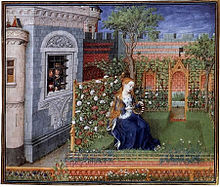
Teseida (full title: Teseida delle Nozze d’Emilia, or The Theseid, Concerning the Nuptials of Emily)[1] is a long epic poem written by Giovanni Boccaccio c.1340–41.[2] Running to almost 10,000 lines divided into twelve books, its notional subject is the career and rule of the ancient Greek hero Theseus (Teseo), although the majority of the epic tells the story of the rivalry of Palemone and Arcita for the love of Emilia. It is the main source of "The Knight's Tale" in Geoffrey Chaucer's Canterbury Tales, and therefore is the original source of The Two Noble Kinsmen, a collaboration by William Shakespeare and John Fletcher.[3] The exact sources of Boccaccio's knowledge about the ancient Greek world are unknown, but is likely that he gained the knowledge through his close friendship with Paolo de Perugia, a medieval collector of ancient myths and tales.[3]

Jeanne de la Font gained fame in the sixteenth century by writing a French verse adaption of Teseida.[4]
- ^ Burrow, J. A. (2004). "The Canterbury Tales I: romance". In Piero Boitani (ed.). The Cambridge Companion to Chaucer (Second ed.). Cambridge: Cambridge UP.
- ^ Teseida, The Book of Theseus Boccaccio, Giovanni, 1313–1375. New York : Medieval Text Association, [1974]
- ^ a b Before the Knight's tale : imitation of classical epic in Boccaccio's Teseida Anderson, David. Philadelphia : University of Pennsylvania Press, c1988.
- ^ Robin, Diana Maury; Larsen, Anne R.; Levin, Carole (2007). Encyclopedia of women in the Renaissance: Italy, France, and England. ABC-CLIO, Inc. p. 198.